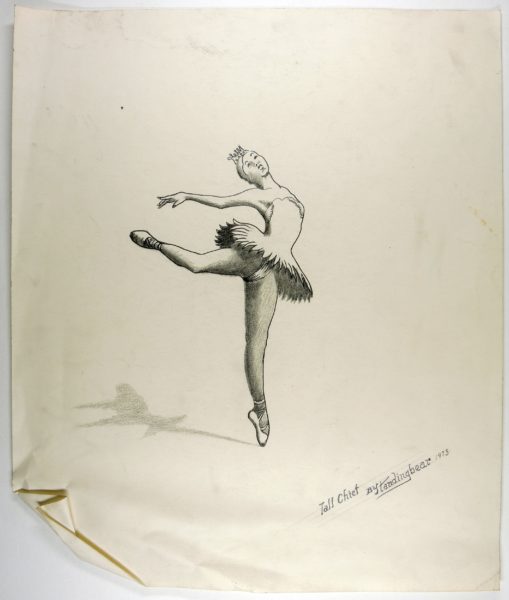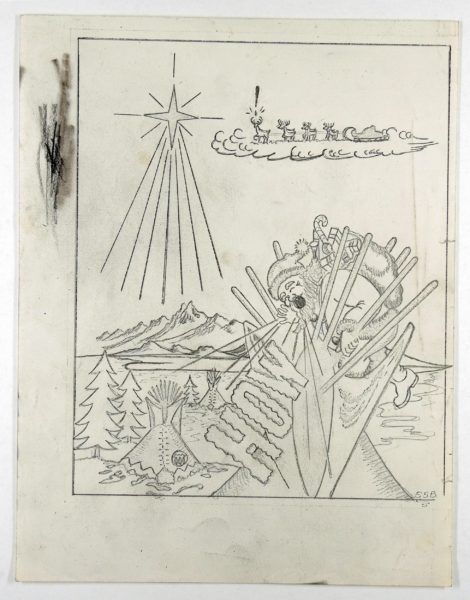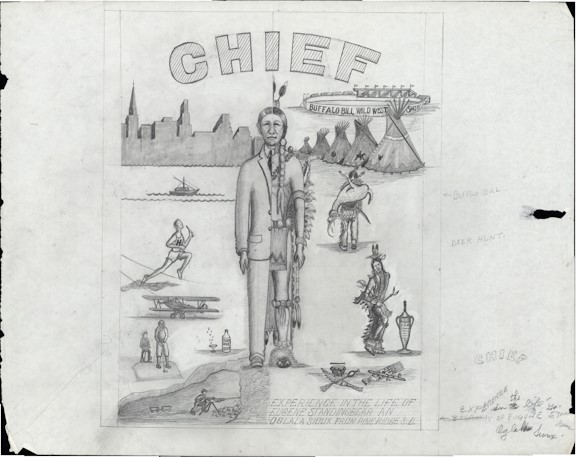This guest post was written by Bethany Williams, Collections Access Coordinator, History Colorado. Content from “Between Two Worlds: The Life and Art of Eugene Standingbear”, Colorado Heritage, Sept/Oct 2014, by Alisa DiGiacomo, Director of Curatorial Services
History Colorado is pleased to share the incredible artwork of Eugene George Standingbear (1906-1980) via the Plains to Peaks Collective, including increasing discoverability of his work through the Digital Public Library of America (dp.la).
A self-taught artist, Eugene Standingbear began drawing in his youth. Pen and paper in hand, he sketched at his mother’s side while she did beadwork. Standingbear also painted, sang, acted, and danced. These art forms kept him connected to his American Indian heritage, and they reflected his life experiences—the joyful and the sorrowful.

Born in 1906, Eugene Standingbear was the son of Sioux Chief Luther Standing Bear (1868-1939) and Laura Cloud Shield. An Oglala Sioux, he grew up on the reservation at Pine Ridge, South Dakota. In his youth, he traveled with his parents in the Buffalo Bill Wild West Show and in the Miller Brothers’ 101 Ranch Show. He went on to work as a barnstormer, mechanical engineer with the U.S. Navy in the Puget Sound Naval Area, miner, cab driver, and musician. He even worked in Hollywood including acting as a medicine man in “Grizzly Adams.” Standingbear eventually settled in Roggen/Keenesburg, Colorado, where he met Jennifer Okada, the collection’s donor.

In 2014, History Colorado received more than 300 drawings by Standingbear, a gift to Jennifer Okada from the artist in the 1970s. Among the drawings is one that clearly speaks to Standingbear’s life in two worlds. In the drawing, Standingbear divides himself in two: half of him wears traditional clothing and is surrounded by images reflecting his life as a Sioux Indian, while half of him wears an Anglo man’s suit, with images of his experiences outside the reservation. Even without knowing the details of Standingbear’s life, the viewer can see that his identity was shaped by two very different cultures.

Almost 40 years after his death, Eugene Standingbear’s dream of being recognized as an artist has come full circle. Connected to his life experiences—from the peak of happiness, to the depth of despair—his writings, dance, music, and visual art have done what he desired them to do: provide a better understanding of him as an individual, preserved his American Indian heritage, taught younger generations the value of respect for others who may come from different backgrounds, and served as a reminder that people, even from different cultures, traditions, and religions, can learn something from each other if, despite their differences, they are willing.
Read more about Eugene Standingbear’s life and art in “Between Two Worlds: The Life and Art of Eugene Standingbear”, Colorado Heritage, Sept/Oct 2014, Alisa DiGiacomo.
![]() The Plains to Peaks Collective is a growing collection of historic digitized objects including photographs, artifacts, artwork, manuscripts and oral histories, from cultural heritage institutions in Colorado and Wyoming. These items are shared with the Digital Public Library of America a free online resource of historic collections found throughout the United States. We encourage you to explore, discover and learn from our vast and diverse shared history.
The Plains to Peaks Collective is a growing collection of historic digitized objects including photographs, artifacts, artwork, manuscripts and oral histories, from cultural heritage institutions in Colorado and Wyoming. These items are shared with the Digital Public Library of America a free online resource of historic collections found throughout the United States. We encourage you to explore, discover and learn from our vast and diverse shared history.
- It Takes a Village: New News for Weld and Pitkin Counties - June 26, 2025
- Socialism and a Denver Suburb: New Additions to CHNC - June 6, 2025
- 2025 Support for Newspaper Digitization - November 13, 2024